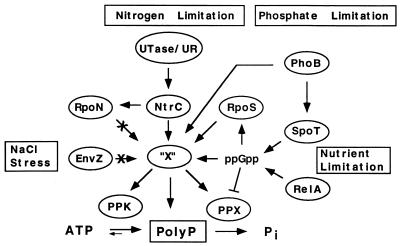FIG. 6.
Model for stress-induced polyP accumulation. Nitrogen is regulated by a signal cascade involving Utase/UR, NtrB, NtrC, and RpoN. NtrC, together with RpoS and PhoB, is needed for polyP accumulation in response to nitrogen limitation. Involvement of a sigma factor (RpoS) implies activation of an additional factor (“X”) which could lead to polyP accumulation by direct interaction with polyP, inhibition of PPX, stimulation of PPK, or a combination of all three. Under nutrient limitation, ppGpp accumulates by RelA and SpoT actions, which can lead to polyP accumulation by PPX inhibition and/or RpoS activation. Failure to accumulate polyP when ppGpp and RpoS levels are high (such as under carbon starvation) implies the presence of additional regulator(s). Osmotic stress triggers polyP accumulation through a mechanism that does not involve EnvZ, the osmotic sensor.

